Intel Core Duo: AOpen i975Xa-YDG to the Rescue
by Gary Key on May 4, 2006 8:00 AM EST- Posted in
- Motherboards
Board Layout
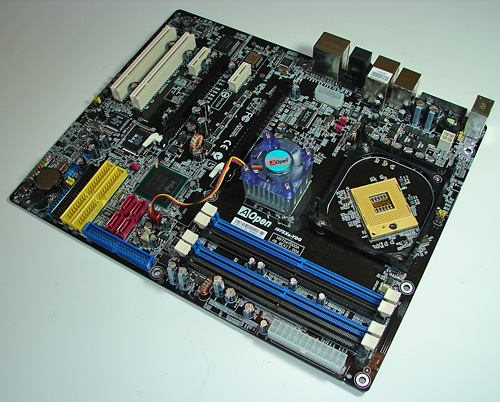
AOpen designed a very well laid out board with all major connections easily reached. The board is lacking most clearance issues and was very easy to install in a mid-size ATX case. The board features an excellent voltage regulator power design along with Rubycon capacitors that yielded superb stability and overclocking results. Here's an enhanced close-up of the capacitors area.

The DIMM module slots' color coordination is correct for dual channel setup based upon the premise of utilizing different colors for each memory bank. The memory modules are easy to install with a full size video card placed in the first PCI Express X16 slot. The 24-pin ATX power connector is located along the upper edge of the board and below the memory modules.
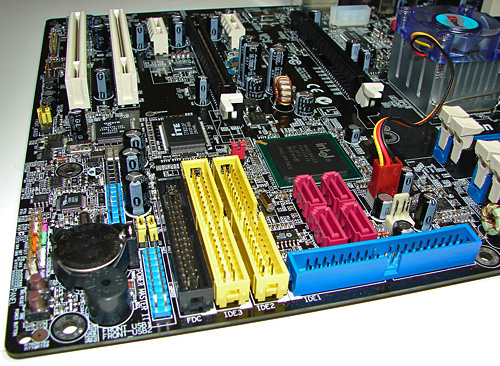
The Intel IDE port connector is the blue IDE socket located along the edge of the board and to the right of the memory modules. This port did not present any connection issues in our mid-size ATX case. The system and Northbridge fan headers are located above the IDE1 port and to the left of the Intel SATA ports.
The four Intel SATA ports are a reddish-pink color and are conveniently located below the Intel ICH7 Southbridge. The SATA ports feature the newer clamp and latch design. We found the positioning of the SATA ports to be excellent when utilizing the PCI-E slots or the Intel IDE port connector. The Intel ICH7 Southbridge does not require a heatsink in this application.
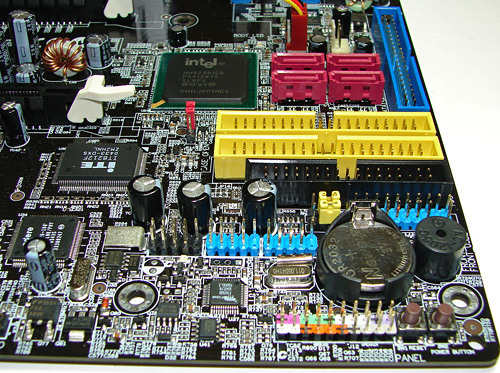
The two yellow IDE port connectors are provide by the ITE chip and are located below the Intel SATA ports. These ports did not present any connection issues in our mid-size ATX case although they could potentially interfere with the SATA ports or might cause a cable length issue in full size ATX cases.
The black floppy drive connector is positioned below the ITE IDE ports. The location of this connector is not ideal and actually the whole point of having a floppy drive connector is becoming moot with the wide spread availability of USB floppy or flash drives along with BIOS support for boot purposes.
The blue IR port is located below the floppy drive connector and above the battery. This connector is required for the Remote Control unit. Take note of the yellow jumpers; if they are not installed correctly the Remote Control unit will not operate correctly. The jumper configuration is not mentioned in the manual.
The nine pins on the black plastic base provide an additional IEEE-1394 connector; this connection is located to the left of the two additional blue USB connectors - not to be confused with the blue IR connection. The chassis panel connections are located at the bottom edge of the board below the battery. AOpen also provides onboard reset and power buttons, a feature that is greatly appreciated and very useful for boards not in a case. Last and actually least used is the clear CMOS jumper block that is a traditional jumper design located below the Intel ICH7 and to the left of the ITE IDE connectors. We did not utilize this jumper throughout our two weeks of testing this board and AOpen should be commended for their BIOS self recovery system and general board stability.
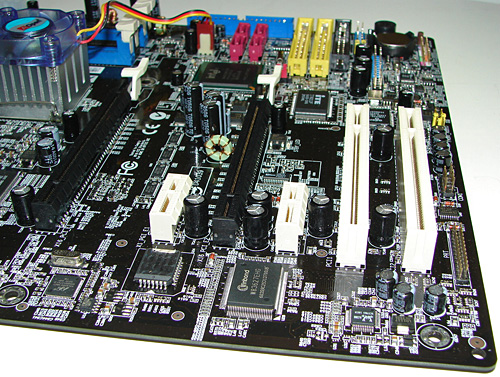
The board comes with (2) physical PCI Express X16 connectors, (2) PCI Express X1 connectors, and (2) PCI 2.3 connectors. The layout of this design offers a good balance of expansion slots for a mainstream board while providing excellent clearance space for card utilization. AOpen designed a two slot opening between the first X16 PCI-E connector and the first X1 PCI-E connector, allowing you to utilize the X1 connector with a dual slot cooling system.
The primary PCI Express X16 connector is located to the far left of the slot areas. The first PCI Express X1 connector is located next, followed by the secondary PCI Express X16 connector. The second PCE Express X1 connector is next, and then last are the (2) PCI slots. Although there are two physical X16 connectors available on the board, they operate in X8 PCI-E mode in multi-GPU or CrossFire mode.
We did not have any issues installing our EVGA 7900GTX 512MB or ATI X1900XTX video cards in the first or second X16 PCI Express slots. A dual slot card located in the second X16 connector will physically render the second PCI Express X1 slot useless. There were no issues utilizing this slot with video cards containing single slot cooling systems.
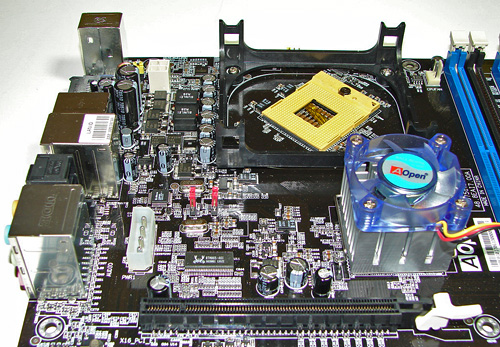
Returning to the CPU socket area, we find an ample amount of room for alternative cooling solutions. We utilized the supplied AOpen heatsink/fan but also verified a couple of Socket-478/9 cooling solutions would fit in this area during our tests. However, due to the low voltages utilized and resulting thermal output, the supplied AOpen heatsink/fan worked fine throughout our testing. The CPU socket is rotated at a 45 degree angle, which we have seen in past Pentium-M configurations.
The Intel 975X Northbridge is actively cooled with a medium sized heatsink/fan unit that did not interfere with any installed peripherals. In fact this unit kept the chipset cool enough that additional chipset voltage was not a factor in our overclocking tests. Our only concern is the lifespan of the fan but it is very quiet during operation. Our advice to AOpen is to install a more effective passive heatsink design and drop the fan as our overclock testing showed no differences between the fan operating or not.
AOpen places the four-pin 12v auxiliary power connector at the top of the CPU socket area but out of the way of aftermarket cooling solutions. The four-pin Molex power connector is located above the first X16 PCI-E connector and must be utilized for multi-GPU or CrossFire operation. This connector is located in a position that can hamper airflow with cabling that crosses directly over the CPU heatsink/fan, though power supplies with longer cables will usually allow you to route cables around the CPU.
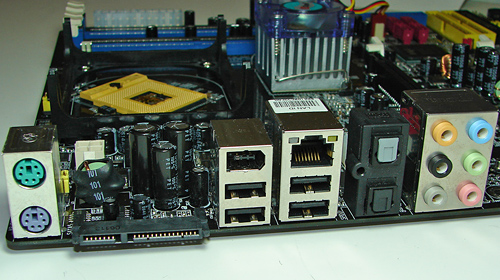
The rear panel contains the standard PS/2 mouse and keyboard ports, LAN port, and 4 USB ports. The LAN (RJ-45) port has two LED indicators representing Activity and Speed of the connection. The audio panel consists of 6 ports that can be configured for 2, 4, 6, and 8-channel audio connections. The rear panel also has two S/PDIF optical ports (In/Out), IEEE-1394 port, and a powered external SATA 3Gb/s port.
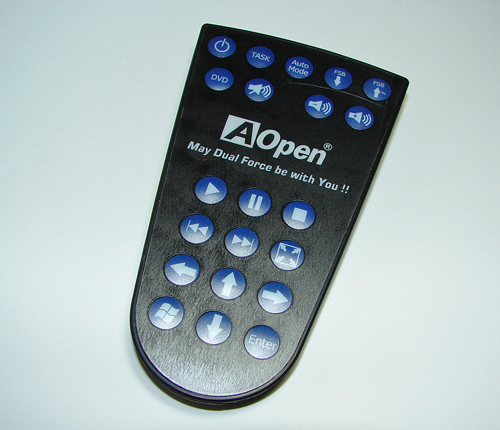
One of the more interesting options we have seen in a motherboard kit is this remote control unit from AOpen. Its main purpose is to control Windows Media Player functions but AOpen designed system on/off and FSB overclocking capability into the mix. Both of these functions proved valuable during the course of our testing, especially the FSB settings as we explored the overclocking limits of our board. (Just don't let your toddler have too much fun pressing buttons on the remote!)










81 Comments
View All Comments
Per Hansson - Wednesday, May 17, 2006 - link
Hi Gary, just wanted to drop in and give you a kudos on this very nice review!It also makes me smile to finally see Intel catching up with AMD, this can only be good news for the customer...
And a small heads up, there are a few Intel Core Duo Engineering sample CPU's on sale at eBay, "hint hint engineering sample=multipler unlocked"
And also a big thanks for finally posting those capacitor shots and mentioning them, keep up the good work!
Also I think Aopen deserves recognition for designing a mainboard with so high-quality components, Rubycon=Way to go!!!
goinginstyle - Friday, May 19, 2006 - link
Agreed....
vailr - Thursday, May 4, 2006 - link
Updated driver:(from: http://www.station-drivers.com/page/intechip.htm)">http://www.station-drivers.com/page/intechip.htm)
Intel Chipset software Installation Utility
Version 7.3.1.1013 - Windows 2000/XP 32/64bits/2003Server Multi Langues & officiel
ftp://aiedownload.intel.com/df-support/10392/eng/i...">ftp://aiedownload.intel.com/df-support/10392/eng/i...
Version 8.0.0.1005 Alpha
Windows 2000/XP 32/64bits/2003Server Multi Langues & non officiel
http://www.station-drivers.com/telechargement/inte...">http://www.station-drivers.com/telechargement/inte... Alpha.exe
Gary Key - Thursday, May 4, 2006 - link
Thank you for posting these links. :) We have a policy of utilizing the latest driver sets on a supplier's website at the time our testing starts, in this case the Intel general download page is still posting the 7.2.2.1006 driver set. However, I am using the 7.3.1 driver set on our retail board sample tonight. ;-)irev210 - Sunday, May 7, 2006 - link
Hello Gary,Sorta funny how that other fellow has absolutely no idea what he is talking about.
I just wanted to touch upon something that I didnt see get much attention.
You should have mentioned in your article about how efficient the core architecture is, and how well it scales with increased frequency. The chip turns into a total monster once you get past 3ghz, and continues to perform better and better as you increase the speed. The fastest I could get on air was around 3.1ghz. I wouldnt be afraid to crank the volts to the 1.5 max on the aopen board... with a different cooler, you should hit some nice speeds. Try swapping out for a zalman 9500, or a big typhoon.
The shortfalls, are as you mentioned the southbridge lacking raid, and the poor bios options. Vcore should let us up to 1.65-1.7, while Vdimm should let us do atleast 2.3.
While this may not satisfy the most serious enthusiast, this board does fill a nice niche. The price is pretty high, but core duo CPU's can be had on the cheap, which makes up for it. For someone that is worried about their electric bill, and wants performance and performance per watt, this is a great alternative.
For others who must have the fastest. This just makes them drool. This is the low end of the core architecture. Merom and Conroe to follow... we shall be stunned.
Consdering Meroms being tested now at 3.0Ghz are faster than 3.2Ghz Yonah's... AND YOU WILL SEE Conroe EE at 3.33 w/ a 1333fsb doing 4ghz w/ 1500mhz FSB :)
For those that dont get it yet... AMD will need a AM2 processor running at about oh 4.8Ghz to beat a 4Ghz clocked conroe :)
Good things to come. I take no sides, im just excited about new stuff :)
Marlowe - Thursday, May 4, 2006 - link
How come a ~1 % cpu usage translates into a massiv 20 fps drop in BF2? Looks like EA have a deal with Creative :(A lot of world records have been beaten with this mobo already over here at XS :)
coolaler even got SLI enabled on it ;) also running a merom in it ;)
Your 266 FSB is very good and about normal for aircooling. Give it some cold and it will go further ;)
Frumious1 - Thursday, May 4, 2006 - link
[font color="#000000] (Damn white text. Nice comment engine AnandTech.... Need a new programmer?)Because RightMark is a theoretical test and not actually a real game or audio application. Also, look at the 3D/EAX scores - it's more than 1% CPU usage, but still less than 20% or whatever.
Gary Key - Thursday, May 4, 2006 - link
It has to do with the Realtek driver load and Creatives to some extent being split between the cores during the RightMark testing. I noted in the text that although the cpu utilization is extremely low in our Rightmark results due to the load balancing that the actual game results (percentage differences) were basically the same as our single core scores. The drop in BF2 is due to the audio algorithms being generated by the CPU rather in hardware as on the X-FI card. Our audio settings in BF2 are set to hardware, medium quality, EAX enabled, the high quality setting extracts another 6FPS but we generally have not noticed an increase in audio quality. This is one penalty you pay for on-board audio in a CPU limited game although Serious Sam II is the one exception for either solution.
We are hoping to receive a T2700 chip from Intel shortly and will "chill" it to see what results come from it. :) Yes, we had SLI working on the board also, but that is a topic that will be buried with Jimmy Hoffa at this time. ;-)
NT78stonewobble - Friday, May 5, 2006 - link
Intriguing last 2 sentences.The comments section has some really good info alot of the time :).
And kudos for bringing into the review something about the penalty for using onboard audio versus dedicated hardware.
You're not by any chance planning on writing something about audio quality some-time? Not that im an audiophile or the like, just curious.
Gary Key - Friday, May 5, 2006 - link
We will expand our audio section in the next update to our motherboard review section. We are looking at several variations of the review process as we enter a very busy time of the year with AM2, Conroe, and others all launching over the next 90 days. :)